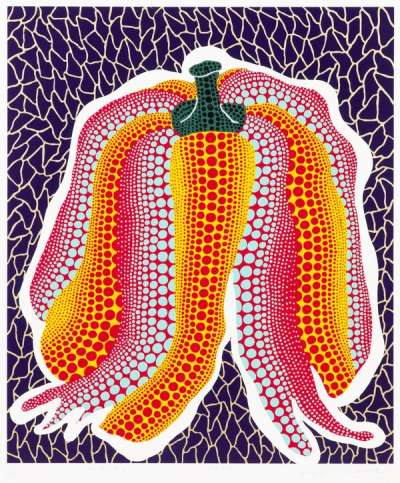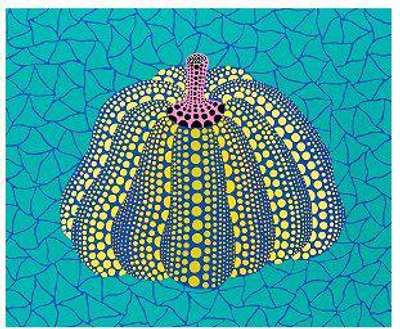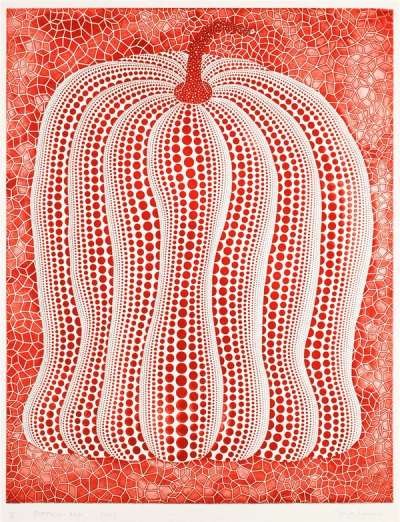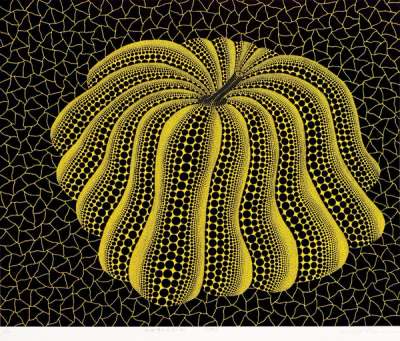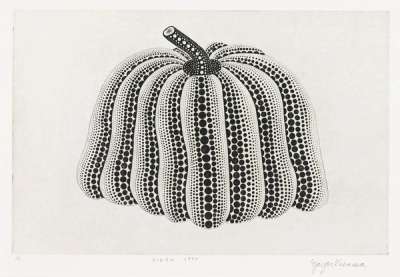 Pumpkin (OG) , Kusama 156 © Yayoi Kusama 1992
Pumpkin (OG) , Kusama 156 © Yayoi Kusama 1992Live TradingFloor
From her early familial ties to agriculture that sparked a lifelong fascination with pumpkins, to her innovative dot technique that brings these organic forms to life, Yayoi Kusama has consistently elevated the humble vegetable to iconic status. Equally rooted in personal memories and universal themes, her pumpkins rival the recognisability of Warhol's Soup Cans. Whether capturing the essence of infinity with her intricate net patterns or playing with a kaleidoscope of colours, Kusama's Pumpkins offer a visual feast that resonates globally.
Yayoi Kusama created her first Pumpkin artwork, Kabocha, in 1946
 Pumpkin (YY) , Kusama 231 © Yayoi Kusama 1996
Pumpkin (YY) , Kusama 231 © Yayoi Kusama 1996This artwork marked the inception of a motif that would become integral to her legacy. While Kusama has explored a myriad of themes and mediums throughout her career, the pumpkin holds a place of particular significance. Originating in the post-war era, Kabocha (Pumpkin) not only showcases Kusama's style but also offers a glimpse into her personal connection to the vegetable, rooted in her family's occupation. This early piece foreshadowed the pumpkin's recurrent presence in Kusama's oeuvre, from sculptures and paintings to large-scale installations.
Collaborating with Tate, Kusama made multiple soft pumpkins
 Pumpkin (RT) , Kusama 316 © Yayoi Kusama 2004
Pumpkin (RT) , Kusama 316 © Yayoi Kusama 2004Kusama's partnership with the prestigious Tate Modern Gallery led to the birth of a series of soft pumpkins, marking a unique tangent in her pumpkin-infused journey. While Kusama's earlier works mostly manifested in robust sculptures or vivacious paintings, this collaboration showcased a softer, tactile aspect of her vision. These soft sculptures captured the "warm and human-like" essence of pumpkins that Kusama often referred to. The collaboration was an embodiment of two art powerhouses coming together: Kusama's timeless creativity and Tate's global platform.
Kusama was introduced to pumpkins by her parents
 Pumpkin (black and white) © Yayoi Kusama 1995
Pumpkin (black and white) © Yayoi Kusama 1995Kusama's early introduction to the world of pumpkins was deeply rooted in her family background. Growing up, her parents were involved in the business of selling seeds, immersing Kusama in a universe of agriculture and natural themes. This familial occupation not only acquainted her with various plant species but prominently highlighted the pumpkin, which later would become an emblem in her career.
Kusama's dot technique represents the three-dimensional form of the pumpkins
 Pumpkin (OG) , Kusama 156 © Yayoi Kusama 1992
Pumpkin (OG) , Kusama 156 © Yayoi Kusama 1992Kusama's self-developed dot technique transforms a two-dimensional surface into a vivid three-dimensional visual experience for her viewers. By varying the size, density, and arrangement of these dots, Kusama is able to convey the roundness and tactile nature of the pumpkins, adding a sense of volume and spatial perspective.
Kusama's pumpkin artworks have been likened to Warhol's Campbell's Soup
 Pumpkin (yellow) , Kusama 4 © Yayoi Kusama 1982
Pumpkin (yellow) , Kusama 4 © Yayoi Kusama 1982Kusama’s been able to elevate the humble pumpkin to a symbol comparable to that of a Pop-Art giant. While Andy Warhol's Soup Cans comment on mass production and consumerism in Post-War America, Kusama's pumpkins resonate with personal memories and the intriguing duality of the organic form. Both, in their respective contexts, have become iconic, allowing even the general public to instantly recognize the artist behind the work. This comparison points to the power of everyday objects in the hands of visionaries: a simple item, when seen through their eyes, can become an emblem of their legacy.
Pumpkins were incorporated into Kusama's dot artworks in the 1980s
 Pumpkin (red) © Yayoi Kusama 1998
Pumpkin (red) © Yayoi Kusama 1998The 1980s marked a significant turning point with Kusama’s introduction of pumpkins into her famed Dots. This decade witnessed a merging of two powerful symbols that came to define much of her oeuvre: the pumpkin and the polka dot. The dot, which had been a recurring theme in Kusama's works since the 1960s, representing both obliteration and infinity, found a new canvas in the form of the pumpkin. This integration highlighted the pumpkin's contours and anthropomorphic features, giving it depth and dynamism.
Pumpkins make up half of her top auction sales
 Pumpkin (green) © Yayoi Kusama 1999
Pumpkin (green) © Yayoi Kusama 1999Of Kusama’s top auction sales, pumpkins make up half. Pumpkin (LPASG) of course was the priciest pumpkin boasting a resounding £6 million. Kusama’s standout sculpture, Pumpkin, sold for at £5.3 million; Pumpkin (Twpot) for £5.3 million, Pumpkin for £5.0 million and Pumpkin SKLO for £4.6 million. If the past few years alone are any indicator of their demand, we should expect their value to continue soaring in the secondary market.
It showcases a diverse colour palette
 Pumpkin (multicoloured) © Yayoi Kusama 1990
Pumpkin (multicoloured) © Yayoi Kusama 1990While Kusama's sculptures are renowned for their size and evocative textures, her printed artworks captivate with a vibrant array of colours. Beyond her signature black-yellow combination, Kusama often experiments with elaborate palettes, as seen in Pumpkin (multicoloured), which splendidly juxtaposes red, yellow, light blue, and purple to create a sunset-like ambiance. Her meticulous dot technique and ingenious colour blending yield optical illusions of intermediary hues, like shades of pink that don't actually exist, showcasing her prowess in reimagining the traditional still life genre.
Pumpkin (LPASG) sold for over £6 million
 Pumpkin (blue) © Yayoi Kusama 1999
Pumpkin (blue) © Yayoi Kusama 1999 In 2021, Kusama’s 2013 Pumpkin (LPASG) artwork sold for over £6 million at Christie's Hong Kong. The staggering amount also positioned the piece as one of Kusama’s highest selling works ever, further solidifying her force in the contemporary art market. Pumpkin (LPASG) epitomises Kusama’s decades-long exploration, fusing her characteristic polka dots with the organic form of the pumpkin. Its 2021 sale at Christie's Hong Kong not only reflects the artwork's individual merit but also the broader trend of growing appreciation for Asian artists in the global art market.
They feature the same pattern seen in Infinity Nets
 Dancing Pumpkin (YOR), Kusama 321 © Yayoi Kusama 2004
Dancing Pumpkin (YOR), Kusama 321 © Yayoi Kusama 2004Kusama's iconic pumpkin artworks often incorporate her mesmerising Infinity Net patterns. These patterns, characterised by intricate grids of web-like shapes, symbolise Kusama's lifelong interest in the concept of infinity and provide therapeutic relief for the artist as well. Her fusion of the nets with her pumpkins highlights their relationship between repetition and singularity, embodying her exploration of infinity within a finite form.


